How I learned to ‘bend time’ and put in an honest workday
By Angie Gallop
I’m a mother with two children under age five, a writer, the co-owner (with my husband) of a thriving freelance business and, oh… did I mention I run a small literary festival?
Between asking my four-year-old to stop wiggling so I can get her hair brushed; getting the 22 month-old into a new diaper; walking these children to school (something I would never miss); then coming home to carefully walk past the sinkful of dishes, basketful of laundry, and errant toys strewn on the floor to get to my desk; the amount of focus I need to get down to work can be daunting.
Never mind the temptation of e-mail and social media… open either I can be sunk for the day.
Willpower is like a muscle: it gets tired with use
One look at the lives of freelance writers, who typically work where they live, and it’s no wonder that the weekly planning, obsessive time-mapping, and lists – oh the lists – often don’t work.
Don’t get me wrong. Plans are good. But, it’s willpower, not lists and plans that makes or breaks a writer.
Which is why this writing assignment is a blessing: after years of preaching about the pomodoro technique, a time management method that supports the practice of willpower, I get to fully dive in and tell you about it.
What is the Pomodoro Technique?
Author Francesco Cirillo, started out with a simple, pomodoro (Italian for ‘tomato’)-shaped kitchen timer to develop this technique.
The basic challenge is to set that timer and work, without distraction, for 25 minutes. Start by orienting yourself for five minutes, work for 15 minutes then, during the last five minutes, review progress and figure out your task for the next pomodoro.
When the timer rings, set it for a five-minute break, where you can go to the washroom, refresh your tea etc. After four pomodoros, take a longer, 15-30 minute break.
Seriously, is that it?
Well, it can be.
If you ‘pomodoro’ like I’ve been for the past few years, you’re on deadline and set your timer for 25 minutes. Sometimes you make it, sometimes you don’t. No matter. You set the timer and try again. Sometimes you take breaks, but often you don’t. Wasn’t the whole point to get going? You meet the deadline, forget the timer, and fritter away days with those other distractions until the next deadline comes along.
Then you dig through your office and find the timer again. Ultimately the technique has not changed how you experience your workday or the fact that your deadlines, rather than you, control your time.
Set yourself up properly
Done properly, the pomodoro technique will increase your intensity at work and help you meet deadlines calmly.
If you want to do this thing right, you’ll need a notebook along with that kitchen timer.
At the back, set up a page like this:
The Activity Inventory is your master ‘To Do’ list. Dump the nagging tasks from your brain and those little sheets of paper cluttering your desk onto this page. Mark the deadlines in the left-hand column. In the right-hand column, make an estimate. How many pomodoros will it take to complete each? If an activity takes more than 5-7 pomodoros, break it up into smaller tasks. Cirillo’s rule is there are no ½ or ¼ pomodoros. If a task can’t fill the time, add others to the same pomodoro.
At the front of your notebook, set your page up like this:
Pick items from your Activity Inventory to fill in your ‘To Do Today’. In the left column, note deadlines. In the right column, put boxes for each pomodoro you’ve estimated. Below, create a section called ‘Unplanned and Urgent’.
A word to computer-nerds
Cirillo is, himself, a software developer yet he recommends starting out with a pen and notebook. Why? The more complexity you add with spreadsheets and interactive calendars, the more time you’ll need to tinker with your system.
There are plenty of pomodoro apps out there, but only go tech if it makes sense, ie: if your team is geographically dispersed and you want to share results.
Go! Conduct your day the pomodoro way
Wind up your kitchen timer and start. You may find the ‘tick, tick, tick’ annoying but relax, you’ll see it acts as a reminder that you are on the clock and helps you keep your intensity.
If you are interrupted, quit the pomodoro. Put a tick in the box on your list to indicate the abandoned pomodoro. Then wind your timer back to 25 minutes and start again.
If you experience what Cirillo calls an ‘internal interruption’, ie: you suddenly realize you need to sign up your child for swimming lessons, note it in the Unplanned and Urgent section and keep going.
When you’ve completed a pomodoro, put an X in the next box. Then wind your timer to five minutes and take a break.
After four consecutive pomodoros, congratulations! Take a longer break of 15-30 minutes.
If your task is taking up more pomodoros than you estimated, add in boxes of a different shape. This way, you’ll develop a more accurate picture of your reality vs. your estimate for that particular task.
Work with the pitfalls
Like any practice ‑ yoga, running, writing – this technique involves trying each day. It’s not about being perfect.
Cirillo writes beginners may be challenged to complete one full pomodoro a day.
I completed seven uninterrupted pomodoros on my first day, but only two the next. Yet even on that difficult day, I accomplished something.
I guarantee you’ll find it difficult to stop either your breaks or your pomodoros. Do it anyway, however imperfectly. Stopping work when that timer rings helps you refresh and refocus. Keeping breaks short helps you maintain your intensity.
Benefits
I’ve been back to the pomodoro technique for more than a week now. It’s easier to get to my desk and do my creative work before the urgent stuff because I know it’ll only take up a few pomodoros. I’m having fun because my workday feels more like a training session or game — how many completed pomodoros can I get in before lunch? I’ve challenged my husband so we can compare. I figure this will increase my accountability.
I’ve also been making progress toward my physical goals: I take fewer trips to the refrigerator. And, I’m more limber because I’ve been using the short breaks to practice a yoga sequence.
Already, the regular analysis of my results helps me make more accurate time estimates.
By far the biggest benefit happens at 3:30 pm. When I pick up my kids, I’m more present with them because I’ve done my best to put in an honest workday.
Get that notebook and kitchen timer out. In the comments section below, please tell me about your experience with the pomodoro technique and any tips/tricks you’ve learned along the way.
Angie Gallop runs thatwhitepaperguy.com with her husband, and storiesinthenorth.com with a group of co-conspirators. If you read and/or write short stories, she’d love to connect with you on Wattpad at http://www.wattpad.com/user/Evangileen.
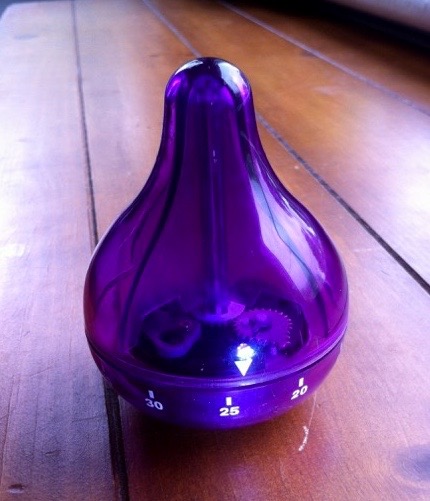
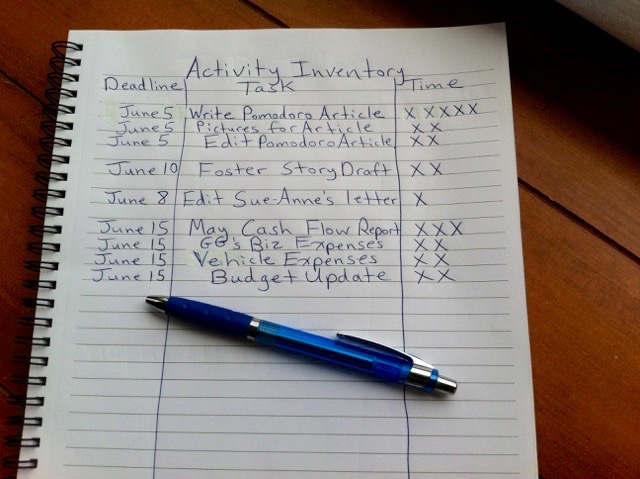
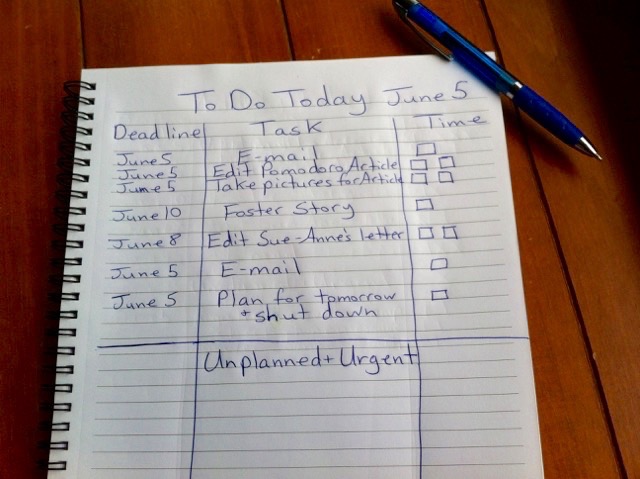
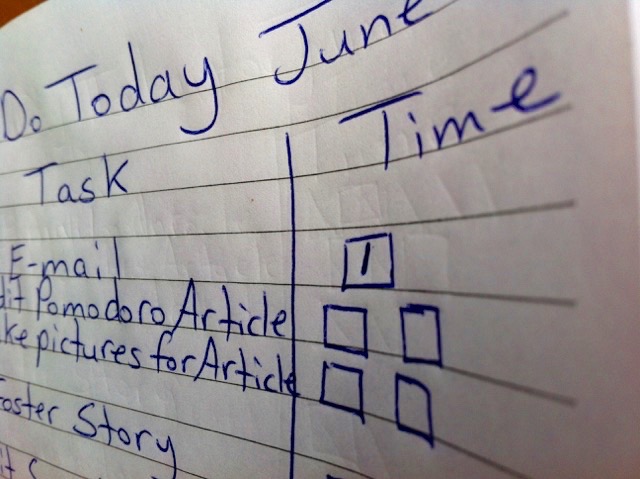
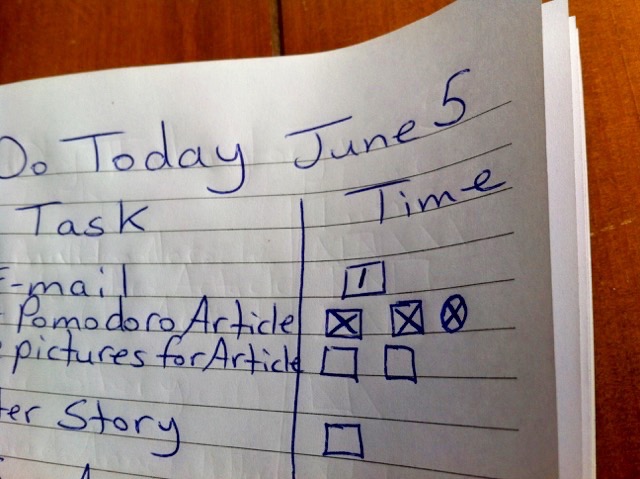




on June 10, 2015 at 3:58 pm
· Permalink
Amazing! Will definitely start this tonight.
on December 10, 2018 at 3:20 am
· Permalink
Thank you for sharing! It helped me learning more about Pomodoro and how to use the sheets.